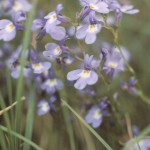Berlandier lobelia
Lobelia berlandieri A. DC.
Campanulaceae (Bluebell family)
Description
Berlandier lobelia is a cool-season annual of the Bluebell family that can reach up to 20 inches tall; however, most plants are less than 12 inches tall.
Most of its leaves originate from the base of the stem and are hairless, oval and up to 2 inches long on short stems. The leaves on the stalks are lance-shaped and much smaller. Berlandier lobelia has from one to 20 thin, ascending branches, each bearing a loose stalk of small, bright, purplish-blue flowers with white "eyes."
The plant is poisonous to both livestock and wildlife.
Habitat
In Texas, these plants are confined to the Rio Grande Plains, but they extend south into Mexico. They are abundant on disturbed rocky, sandy or clay soils in years with adequate fall and winter rainfall.
Toxic Agent
Berlandier lobelia contains nicotine alkaloids that are responsible for its toxicity. The plants are short and inconspicuous until the flowering stalk stage of growth. These plants are palatable and are readily consumed.
Above-average rainfall during the fall and winter almost always results in lobelia poisoning in cattle on the plains south of Kingsville TX. Nelgi antelope have also been poisoned in the same area.
Signs of Livestock Ingestion
Depending on the dose, the nicotine alkaloids are central nervous system stimulants or depressants and result in the following signs: excitability (early and not usually observed in brush pastures), depression, down animals that refuse food and water.
Animals become so severely depressed that they lie down and die from water deprivation and exposure.
Management Strategies
Depressed and down animals often recover if they are moved to the shade and given adequate nutrition (feed and water) by tube. This treatment may have to be repeated daily for up to 2 weeks.
Prevention of poisoning requires moving cattle to pastures not containing a significant amount of the plant in the flower and seed stages.
Severe infestations may be controlled with broadleaf herbicides such as 2, 4-D or Grazon P+D® at 0.5 to 1.0 pounds a.i./acre in the spring with good growing conditions.
Images
Plant Characteristics
Flower Color: Purple
Seed Type: Non-Encapsulated
Duration: Annual
Stem Texture: Hairless/Smooth
Growth Habit: Forbs/Broadleaf
Leaf Shape
 : Simple with Pinnate or Parallel Venation
: Simple with Pinnate or Parallel Venation
Season: Cool
Distribution
 : 02 - Gulf Prairies and Marshes, 06 - South Texas Plains
: 02 - Gulf Prairies and Marshes, 06 - South Texas Plains
Distributions
Distribution refers to the ecological region in Texas that a plant has been found. You can also view a clickable map.
Book: Brush and Weeds of Texas Rangelands (B-6208), Toxic Plants of Texas (B-6105)
Collection: Brush and Weeds, Toxics, Wild Flowers
Livestock Affected: Cattle
Livestock Signs: Excitability, Unable To Eat/Drink, Unable To Rise




